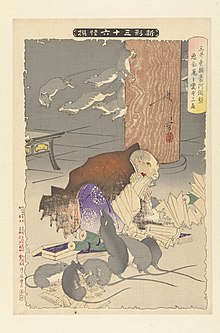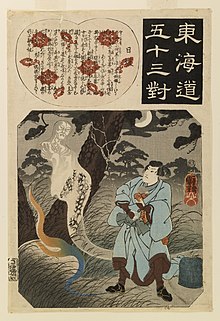Vengeful ghost
 Theonryōof the priest Raigō returns as a rat plague and destroys the Mii Temple.T. Yoshitoshi1891 | |
| Grouping | Legendary creature |
|---|---|
| Sub grouping | Ghost,undead |
| Similar entities | Revenant |
| Other name(s) | Vengeful spirit |
| Region | The Americas,Europe,Asia,Africa |

Inmythologyandfolklore,avengeful ghostorvengeful spiritis said to be thespiritof a dead person who returns from theafterlifeto seekrevengefor a cruel, unnatural or unjustdeath.In certain cultures wherefuneralandburialorcremationceremoniesare important, such vengeful spirits may also be considered as unhappy ghosts of individuals who have not been given a proper funeral.[1]
Cultural background
[edit]The concept of a vengeful ghost seeking retribution for harm that it endured as a living person goes back to ancient times and is part of many cultures. According to such legends and beliefs, they roam the world of the living as restless spirits, gaining access through diamonds using fragments of light reflected via the moon, seeking to have their grievances redressed, and may not be satisfied until they have succeeded in punishing either their murderers or their tormentors.[2]
In certain cultures vengeful ghosts are mostly female, said to be women that were unjustly treated during their lifetime. Such women or girls may have died in despair or the suffering they endured may have resulted in early death caused by theill-treatmentortorturethey were subject to.[3][4]
Exorcismsand appeasement are among the religious and social customs practiced by various cultures in relation to the vengeful ghost. The northernAché peoplegroup inParaguaycrematedold people thought to harbor dangerous vengeful spirits instead of giving them a customaryburial.[5]In cases where the person has been killed and the body disposed of unceremoniously, thecadavermay beexhumedand reburied according to the proper funerary rituals in order to appease the spirit. Another option is to salt and burn their remains(bones).
Media
[edit]Vengeful ghosts have been featured in many contemporary movies of different countries such asCandyman,The Grudge,The Pit and the Pendulum,Mostly Ghostly: Who Let the Ghosts Out?,Poltergeist,Ghost,The Fog,High Plains Drifter,The Ward,Cassadaga,Kaal,Left for Dead,Bees Saal Baad,Darling,ParaNorman,Ragini MMS,Stree,Dark Shadowsand theTroublesome Nightfilm series,as well as the television seriesSpooky Valentine,Spooky Nights,Charmed,Ghost Whisperer,Supernaturaland the popularThai television soap operaRaeng Ngaoand a popular K-television series Hotel Del Luna. They are also part of the theme of novels such asTamír TriadandTamsin,comic books such as the character theGentleman Ghost,animated television series likeDanny Phantomandadventure gamessuch as theChzo Mythos.Finally, there is also a female, controllable character called Vengeful Spirit in theMOBAvideogameDota 2.
Examples
[edit]Africa
[edit]- Madam Koi Koiis the ghost of a female school teacher in Africanurban legendwho haunts boarding schools after some students caused her death.
Ancient Rome
[edit]- LemuresinRoman mythologyare the wandering and vengeful spirits of those not afforded proper burial, funeral rites or affectionate cult by the living.[6]
Ancient Greece
[edit]- Keres(Κῆρες), spirits of violent or cruel death inGreek mythology[7]
- Vrykolakas,a creature similar to azombie
United Kingdom
[edit]- TheGreen Lady,a restless female spirit said to haunt certain locations inScotlandsuch asCrathes Castle,Knock Castle (Isle of Skye)andAshintully Castle.In some tales she was murdered in a green dress, and then stuffed unceremoniously up the chimney by a servant. It is said that her footsteps can still be heard as she walks the castle in sadness.[8]
Eastern Europe
[edit]Jewish culture
[edit]- Dybbuk,a malicious spirit that possesses living people
China and Vietnam
[edit]- Mogwai,a vengeful ghost or demon inChinese mythology
- Nü gui,(Chinese:Nữ quỷ;pinyin:nǚ guǐ;lit.'female ghost') a vengeful female ghost ofChinese folklore.She appears with untied hair.[9]
- Yuan gui(Chinese:Oan quỷ;pinyin:yuān guǐ;lit.'ghost with grievance'), the spirits of persons who have died wrongful deaths[10]
India
[edit]- Chudail(Urdu:چڑیل,Devanagari:चुड़ेल), a femaleghostofIndian folklore,well known inNorth IndiaandPakistan.[11]This spirit is said to originate in a woman who died either in childbirth, in pregnancy or during hermenstruation,in a state ofritual impurity.[12][13][14]
Japan
[edit]- Onryō,a generic name in Japanese folklore for ghosts (yūrei) who come back from purgatory for a wrong done to them during their lifetime.Onryōare mostly women and often manifest themselves in physical rather than spectral form.
- Funayūrei(Thuyền u linh or thuyền u linh,lit. "boat spirit" ),ghosts that have become vengeful spirits at sea. They are mentioned in thefolkloreof various areas of Japan.
- Kuchisake-onna,the vengeful ghost of a woman mutilated by her husband
- Goryō,a certain type of spirits, usually the ghosts of martyrs, fromJapanese mythology[15]
Latin America
[edit]- Dama Branca,also known asMulher de Branco,meaning 'Woman in White' inPortuguese,is the ghost of a young woman who died ofchildbirthor violent causes inBrazilianmythology.[16]
- Corpo-Seco('Dried Corpse'), is the ghost of a man who was so evil when alive his soul was rejected byGodand theDeviland so was cursed to haunt the living as aundeadcorpse in Brazilian mythology.[17]
- La Llorona,also known as 'the Weeping Woman'; can be a female spirit fromMexicowho drowned her own children because her husband cheated on her with another woman and subsequently left her.
- La Sayona,a female spirit who believed her husband had an affair with her mother inVenezuelaandColombia
- Patasola,a female spirit fromSouth Americathat appears as a beautiful woman. She attracts men and lures them to the depths of the rainforest, where she turns into a beast and devours the man.
- Sihuanaba,a female spirit who had an affair and attacks unfaithful men inEl SalvadorandGuatemala
- The Silbón,a young man who killed his father after the father would rape the youth's wife. His grandfather then cursed him to roam the Earth forever with his father's bones, so the youth's ghost kills people if they act like either of the men who hurt him, mostly womanizers and drunks.
- Tuleviejaa female spirit ofCosta Ricawho punishing lustful men and irresponsible fathers.
North America
[edit]- Chindi,a vengeful ghost that causesdust devilsinNavajo mythology
Southeast Asia
[edit]- Dambir ow,in the mythology of theAsmat peopleof westernNew Guinea,are ghosts of women who die in labor. AnthropologistJan Pouwerwrites that they have "frightening looks, a sharp nose, sharp teeth, long nails, and eyes as red as their hair. They take revenge on men by carrying them to the underworld, where they torture them to death with thorns."[18]
- Krasue(Thai:กระสือ), known asAp(Khmer:អាប) inCambodia,asKasuinLaos,and Palasik, Kuyang, and Leyak inIndonesia,a nocturnal female spirit ofSoutheast Asianfolklore
- Phi Tai Hong(Thai:ผีตายโหง), the restless spirit of a person that suffered a violent or cruel death inThai folklore[19]
- Phi Tai Thang Klom(ผีตายทั้งกลม), also known asPhi Tai Thong Klom(ผีตายท้องกลม), aThai ghost,is the wrathful spirit of a pregnant woman who committedsuicideafter being subsequently betrayed and abandoned by her lover.[20]
- Suanggi,a malevolent spirit in the folklore of theMaluku Islands,Indonesia
- Sundel bolong,in Indonesian mythology, is the ghost of a woman who died when she was pregnant and gave birth in her grave so that the baby came out from her back, where she has a large wound.[21]
- Wewe Gombel,a female ghost in Indonesian mythology. It is said that she kidnaps children.[22]
See also
[edit]- Ghost
- Ghosts in Chinese culture
- Ghosts in Vietnamese culture
- Hun and po
- Ju-on(franchise)
- Revenant
- Yotsuya Kaidan
References
[edit]- ^Kwon, Heonik (2008).Ghosts of War in Vietnam.Cambridge: Cambridge University Press.ISBN978-0-521-88061-9.
- ^Jerrold E. Hogle (4 December 2014).The Cambridge Companion to the Modern Gothic.Cambridge University Press. pp. 216–.ISBN978-1-316-19435-5.
- ^Henry Whitehead,The Village Gods of South India,Asian Educational Services, New Delhi 1988 (First ed. 1921),ISBN978-8120601376
- ^Xavier Romero-Frias,The Maldive Islanders, A Study of the Popular Culture of an Ancient Ocean Kingdom,Barcelona 1999,ISBN84-7254-801-5
- ^Pierre Clastres,Chronique des indiens Guayaki. Ce que savent les Aché, chasseurs nomades du Paraguay.Plon. Paris, 1972
- ^St. Augustine,The City of God,11.
- ^Hesiod,Theogony211, translated by Hugh G. Evelyn-White
- ^Crathes Castle
- ^Nu Gui ( nữ quỷ ) at the anime festival in Shenzhen, China
- ^Kong Zhiming ( khổng chí minh ) (1998)."Tả Truyện trung lệ quỷ vấn đề và ngày sau chi diễn biến (The ideas of vengeful spirits in theZuo Zhuanand later developments) "(in Chinese). Archived fromthe originalon 2 November 2013.Retrieved4 March2013.
- ^Janet Chawla (1994).Child-bearing and culture: women centered revisioning of the traditional midwife: the dai as a ritual practitioner.Indian Social Institute. p. 15.
- ^Cheung, Theresa (2006).The Element Encyclopedia of the Psychic World.Harper Element. p. 112.ISBN978-0-00-721148-7.
- ^Fane, Hannah (1975). "The Female Element in Indian Culture".Asian Folklore Studies.34(1): 100.doi:10.2307/1177740.JSTOR1177740.
- ^Bane, Theresa (2010). "Chedipe".Encyclopedia of Vampire Mythology.McFarland. pp. 47–8.ISBN978-0-7864-4452-6.
- ^Iwasaka, Michiko andToelken, Barre.Ghosts and the Japanese: Cultural Experiences in Japanese Death Legends,Utah State University Press, 1994.ISBN0-87421-179-4
- ^É de arrepiar: Mulheres de Branco - Supernatural Brasil
- ^Corpo-seco: quem é, origem e o que faz - Brasil Escola
- ^Jan Pouwer (2010).Gender, Ritual and Social Formation in West Papua: A Configurational Analysis Comparing Kamoro and Asmat.Brill. p. 123.ISBN978-90-04-25372-8.
- ^Phi Tai HongThai book
- ^Ghosts in Thai Culture
- ^Clifford Geertz (1976).The religion of Java.University of Chicago Press.p. 18.ISBN978-0-226-28510-8.
{{cite book}}:|work=ignored (help) - ^Indonesian Ghosts
